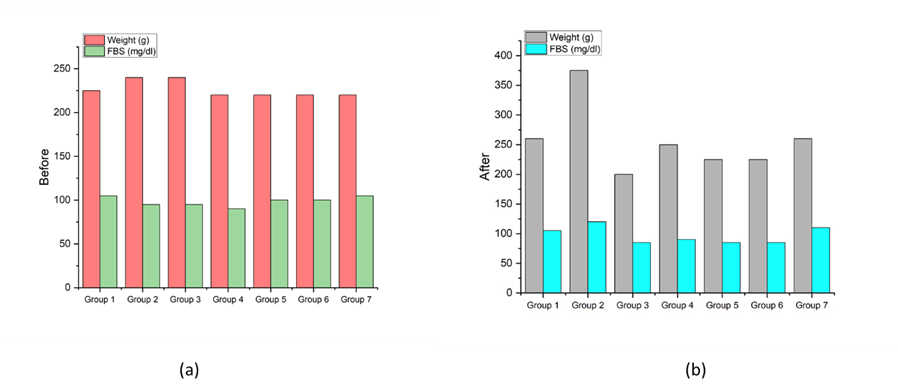Metabolic Biomarker Alterations in a Rat Model of Artificial Sweetener Consumption: Implications for Human Health
Abstract
Due to some variables, especially the rising incidence of being overweight and hyperglycemia, the consumption of NNS has risen significantly globally in recent years. The use of NNS has produced conflicting findings in studies; some data suggest that it leads to weight gain and arises in hunger, while others claim that it has a major impact on weight loss and diabetes management. Using an in vivo rat model, the goal of this investigation is to look at the effects of several sweeteners that are not nutritious, affecting physical size, fasting blood sugar, Overall cholesterol (OC), triglycerides (TC), Extremely Hard lipoprotein (EHL), and Minimal Density lipoprotein (MDL), as well as body weight. According to the findings, stevia caused the rat's weight to drop by 50 grams after eight weeks, whereas, in the other groups, it stayed essentially the same, except for sucrose (G1) and acesulfame-K (G6), which caused a noticeable weight gain. In every group, there was a general rise in LDL and (OC)and a fall in HDL. In terms of shedding pounds and regulating blood sugar levels while fasting, stevia (G2), Sucralose (G3), aspartame (G5), and saccharine (G4) were discovered to be the most advantageous. In addition, conflicting findings from several studies underscore the ambiguity around the impacts of NSS.
References
Walbolt, J. and Koh, Y., 2020. Non-nutritive sweeteners and their associations with obesity and type 2 diabetes. Journal of Obesity & Metabolic Syndrome, 29(2), p.114.
Che, T., Yan, C., Tian, D., Zhang, X., Liu, X. and Wu, Z., 2021. Time-restricted feeding improves blood glucose and insulin sensitivity in overweight patients with type 2 diabetes: a randomized controlled trial. Nutrition & Metabolism, 18, pp.1-10
Park, S., Sethi, S. and Bouret, S.G., 2019. Non-nutritive sweeteners induce hypothalamic ER stress causing abnormal axon outgrowth. Frontiers in Endocrinology, 10, p.876.
Putnik, P., Bezuk, I., Barba, F.J., Lorenzo, J.M., Polunić, I. and Bursać, D.K., 2020. Sugar reduction: Stevia rebaudiana Bertoni as a natural sweetener. In Agri-food industry strategies for healthy diets and sustainability (pp. 123-152). Academic Press.
Hadisurya, M., Lee, Z.C., Luo, Z., Zhang, G., Ding, Y., Zhang, H., Iliuk, A.B., Pili, R., Boris, R.S. and Tao, W.A., 2023. Data-independent acquisition phosphoproteomics of urinary extracellular vesicles enables renal cell carcinoma grade differentiation. Molecular & Cellular Proteomics, 22(5).
Martínez, X., Zapata, Y., Pinto, V., Cornejo, C., Elbers, M., van der Graaf, M., Villarroel, L., Hodgson, M.I., Rigotti, A. and Echeverría, G., 2020. Intake of non-nutritive sweeteners in Chilean children after enforcement of a new food labeling law that regulates added sugar content in processed foods. Nutrients, 12(6), p.1594.
Abdulqader, M.N., Jasim, S.A., Yahya, M.M. and Thanoon, I.A., 2022. Artificial Sweeteners Connoted Vitiation of Rat Metabolic Biomarkers. Revista Electronica de Veterinaria, pp.296-303.
Dawood, M.N., Jassim, S.A., Fadel, M.A. and Thanoon, I.A., 2022. Artificial Sweeteners Perturbed Liver Enzymes in Rat Model. Pharmacognosy Journal, 14(5).
Chiang, Y.F., Chen, H.Y., Lai, Y.H., Ali, M., Chen, Y.C. and Hsia, S.M., 2022. Consumption of Artificial Sweetener Acesulfame Potassium Increases Preterm Risk and Uterine Contraction with Calcium Influx Increased via Myosin Light Chain Kinase–Myosin Light Chain 20 Related Signaling Pathway. Molecular Nutrition & Food Research, 66(20), p.2200298.
Yu, Z., Wang, Y., Henderson, I.R. and Guo, J., 2022. Artificial sweeteners stimulate the horizontal transfer of extracellular antibiotic-resistance genes through natural transformation. The ISME Journal, 16(2), pp.543-554.
Swithers, S.E., 2013. Artificial sweeteners produce the counterintuitive effect of inducing metabolic derangements. Trends in Endocrinology & Metabolism, 24(9), pp.431-441.
Yang, Y., Yu, J., Huo, J. and Yan, Y., 2023. Sesamolin Attenuates Kidney Injury, Intestinal Barrier Dysfunction, and Gut Microbiota Imbalance in High-Fat and High-Fructose Diet-Fed Mice. Journal of Agricultural and Food Chemistry.
Li, P., Li, M., Wu, T., Song, Y., Li, Y., Huang, X., Lu, H. and Xu, Z.Z., 2022. Systematic evaluation of antimicrobial food preservatives on glucose metabolism and gut microbiota in healthy mice. npj Science of Food, 6(1), p.42.
Singh, A., Rourk, K., Bernier, A. and de Lartigue, G., 2023. Non-Nutritive Sweetened Beverages Impair Therapeutic Benefits of Metformin in Prediabetic Diet-Induced Obese Mice. Nutrients, 15(11), p.2472.
Li, L., Xia, J., Huang, Z., Liu, W., Cui, Z., Zhang, Y., Zhang, S., Zou, Y., Liu, W. and Qi, Z., 2023. Sugar-sweetened beverage consumption retarded weight gain but not induced depression and anxiety-like behaviors in mice. Life Sciences, 317, p.121469.
Bian X, Chi L, Gao B, Tu P, Ru H, Lu K. The artificial sweetener acesulfame potassium affects the gut microbiome and body weight gain in CD-1 mice. PloS one. 2017 Jun 8;12(6):e0178426.
Polyák É, Gombos K, Hajnal B, Bonyár-Müller K, Szabó S, Gubicskó-Kisbenedek A, Marton K, Ember I. Effects of artificial sweeteners on body weight, food and drink intake. Acta Physiologica Hungarica. 2010 Dec 1;97(4):401-7.
Ajami M, Seyfi M, Hosseini FA, Naseri P, Velayati A, Mahmoudnia F, Zahedirad M, Hajifaraji M. Effects of stevia on glycemic and lipid profile of type 2 diabetic patients: A randomized controlled trial. Avicenna Journal of Phytomedicine. 2020 Mar;10(2):118.
Amin KA, AlMuzafar HM. Alterations in lipid profile, oxidative stress, and hepatic function in rats fed with saccharin and methyl-salicylates. International Journal of Clinical and Experimental Medicine. 2015;8(4):6133.
Damnjanovic I, Kitic D, Stefanovic N, Zlatkovic-Guberinic S, Catic-Djordjevic A, Velickovic-Radovanovic R. Herbal self-medication use in patients with diabetes mellitus type 2. Turkish journal of medical sciences. 2015 Jul 23;45(4):964-71.
Younis HY, Imad A. Effect of zinc as an add-on to metformin therapy on serum lipid profile and uric acid in type 2 diabetes mellitus patients. Curr topics in Pharmacology. 2021;25.
Merkhan MM, Abdullah KS. The role of vitamin C and E in improving hearing loss in patients with type 2 diabetes. Annals of the College of Medicine, Mosul. 2020 Jan 29;41(2):184-9.
Mirmiran P, Bahadoran Z, Azizi F. Functional foods-based diet as a novel dietary approach for management of type 2 diabetes and its complications: A review. World Journal of Diabetes. 2014 Jun 15;5(3):267.







